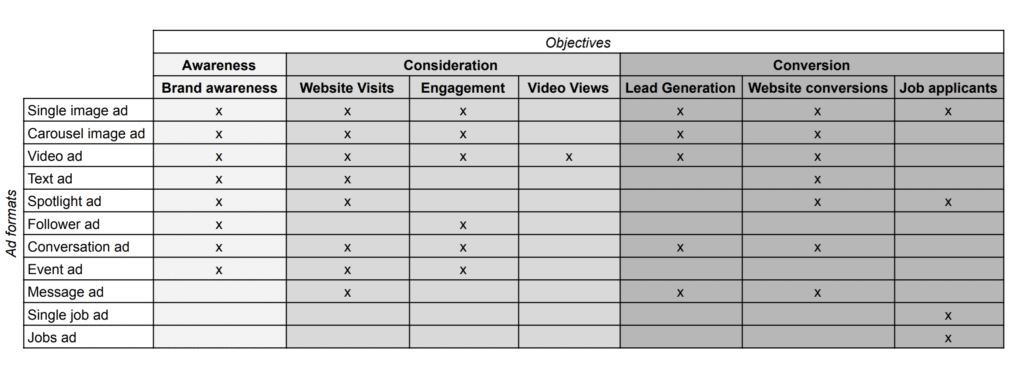LinkedIn Ads Guide: A 3 Step Approach to LinkedIn Ads - BFO
September 23, 2021
8 Minute Read

LinkedIn has become the undeniably best platform to target B2B audiences. This should come as no surprise, as it was built specifically for business networking, making it the ultimate social network for B2B marketers. LinkedIn is currently one of the top three most effective social media platforms B2B marketers use for content marketing purposes alone. To advertise on LinkedIn, marketers must determine their objective, target their audience, and then select an available LinkedIn ad type they would like to utilize. Here’s a three-step approach on how to run ads on LinkedIn and a couple of LinkedIn ad campaign best practices to make your ad campaigns more effective.
Step 1: Determine your LinkedIn ad objectives: “the why”
Social media advertising, in a sense, breaks the traditional marketing funnel, and you cannot expect the same conversions when advertising on LinkedIn compared to a paid search campaign. With the non-traditional marketing funnel, prospects can enter and exit anywhere in the funnel. In LinkedIn, the ad objectives are set up as the marketing funnel. The top of the funnel starts with awareness, then consideration in the middle, and the bottom of the funnel is conversion.
What are you trying to achieve and why are you doing a LinkedIn ad campaign? If you are looking to drive awareness, your only ad objective option is brand awareness. If you are trying to drive consideration, then your objectives could be to drive the following: website visits, engagement, or video views. Lastly, if you’re seeking conversion, the ad objectives options are: lead generation, website conversions, or job applicants.
It’s important to make sure you’re aware of your KPIs and select your objective accordingly. If your KPI is to drive conversions, but you select the awareness LinkedIn objective, you will not see positive results as the algorithm will only optimize to what you select. Also, it is important to note that you can only choose one objective per campaign.
Step 2: Define your LinkedIn audience: “the who”
LinkedIn advertising, like all of the social media platforms, is different from paid search as it focuses on the audience not keywords. Marketers need to understand who it is they want to talk to and this starts with your ideal client profile (ICP). From ICPs, you can build the audience profile needed for LinkedIn advertising. Audience attributes that can be selected include company size, member schools, interest, groups, skills, job titles, seniority, etc.
You can also include custom audiences. For example, if you have a target account-based list, you can upload this list to be used as part of the audience. Another custom audience option is using lookalike audiences, which may or may not be aware of your brand. Even third-party lists can be used.
We usually recommend setting your audience to 300,000 contacts at a minimum initially as it provides room for the ads to run and obtain metrics. However, the optimal number of contacts will vary for every company.
Step 3: Select your LinkedIn ads
At a macro level, there are four LinkedIn ad types: sponsored content (appears in the LinkedIn feed), sponsored messaging (advertising in LinkedIn messaging), lead gen forms (pre-filled out forms that accompany ads), and text and dynamic ads (top and right-hand side of LinkedIn’s desktop feed). The number one most used ad type on LinkedIn is sponsored content, with sponsored messaging ads coming in a close second.
After selecting the objective and audience, you are able to view the ad formats available based on that selected objective. Not every ad format is available in every objective as the ads are designed intentionally to help you achieve your selected objective. The table below shows a summary of what LinkedIn ad formats options for each objective:

Single Image Ads
Single image ads appear on LinkedIn’s homepage and will look like regular content (aka a native post), but these are paid for and will be specifically labeled as “promoted”. Single image ads can be used to achieve the following objectives: brand awareness, website visits, engagement, lead generation, website conversions, and job applicants. See the LinkedIn single ad specs for more information.
Carousel Ads
Carousel ads are multiple images or a mini-slideshow that can tell your story in an interactive, swipeable carousel format. Carousel ads can be used to achieve the following objectives: brand awareness, website visits, engagement, lead generation, and website conversions. See the LinkedIn carousel ad specs for more information.
Video Ads
Video ads allow you to get creative and promote your brand with engaging content. This ad format allows you to “show” and not just tell. Video ads can only be used to drive the video views objective. See the LinkedIn video ad specs for more information.
Text Ads
Text ads are easy to begin with because they are extremely easy to set up and work with, regardless of your budget size. Text ads can be used to achieve the following objectives: brand awareness, website visits, and website conversions. See the LinkedIn text ad specs to find more specific information on this ad type.
Spotlight Ads
This ad takes the audience directly to a landing page or website. It’s a dynamic ad which can be personalized to better connect with your audience. Spotlight ads can be used to achieve the following objectives: brand awareness, website visits, engagement, lead generation, and job applicants. Here, you can find more information on LinkedIn spotlight ad specs.
Follower Ads
This ad type advertises your LinkedIn Page to increase your page followers. Follower ads are also dynamic and can be personalized to your audience. Follower ads can be used to attain the following objectives: brand awareness and engagement. See the LinkedIn follower ad specs to learn more.
Conversation Ads
A sponsored messaging type of ad that is an open-ended conversation between your brand and your audience, enabling them to respond to what resonates with their needs. Conversation ads can be used to accomplish the following objectives: brand awareness, website visits, engagement, lead generation, and website conversions. See the LinkedIn conversation ad specs.
Event Ads
LinkedIn event ads drive LinkedIn event registration with advertising dollars. Event ads support the following objectives: brand awareness, website visits, and engagement. See the LinkedIn event ad specs.
Message Ads
This is another sponsored messaging ad type that enables you to send direct messages to your audience with a call to action of your choice. LinkedIn stats show that more than 1 in 2 prospects open up a message ad. Objectives supported include: website visits, website conversions, and lead generation. See the LinkedIn message ad specs.
Single Job Ads
Single job ads are a LinkedIn sponsored content ad format. These ads promote a LinkedIn job and appear directly in a member’s LinkedIn feed. Job applicants is the only advertising objective available for single job ads.
Jobs Ads
Jobs ads are a dynamic ad format where you can promote job listings and personalize ads to reach top talent. Job applicants is the only advertising objective available for job ads.
The top three LinkedIn formats tend to be single image ads, carousel image ads, and video ads. While these may be the most popular, your choice of ad format is contingent upon your objective and what you’re trying to achieve.
Employ LinkedIn advertising best practices
Based on our experience working in LinkedIn advertising, below are a couple of best practices when advertising with LinkedIn to help make your campaigns more effective:
- Test. Test. Test: A good rule of thumb to follow here is to be sure to test different ad types and see what gets the best response. Try different LinkedIn advertising campaigns to attack multiple areas of the marketing funnel e.g. brand awareness and conversions. There are numerous factors that go into finding the best ad type for your brand, and you can measure performance effectively with KPIs (Key Performance Indicators). What works for one company might not work for the next, which is why testing is an essential best practice to follow.
- Professionally implement your insights tag: While you don’t need to have an insights tag set up to do LinkedIn advertising, implementing one will enable conversion measurement. With the insights tag in place, the algorithm can truly optimize towards best performance, and you gain the ability to see conversion metrics so you can make optimizations and bid strategy adjustments accordingly. However, if the tag is not set up properly, it can alter your results. This tends to be a common problem. To make sure the website conversions are coming through properly, we recommend working with a professional to implement the tag.
- Align your sales and marketing efforts: For best results with LinkedIn ad campaigns, sales and marketing need to become joint forces — think of sales as Starsky and marketing as Hutch, better together. Having your sales force engage and conduct LinkedIn outreach provides the human touch. This human touch combined with your advertising on LinkedIn will drive optimal performance.
LinkedIn is a must for every B2B digital marketing strategy. As a recap, the three steps to advertise with LinkedIn that we covered include: establishing your objective, defining your audience, and then selecting your ad format. Further, to ensure your campaign is even more successful, there are several key best practices to follow. Want to learn more about LinkedIn advertising? Check out our on-demand webinar on this topic: Personalizing Your B2B LinkedIn Marketing Strategy. Also, if you need help on how to create a LinkedIn ad campaign or looking for a LinkedIn ads agency, contact us anytime.

James Willingham
James describes his job at BFO as ‘a dream career,’ and we describe him as a ‘dream employee.’ Firstly, James is a foster parent, who has used his skills in digital marketing to promote foster parenting. Family and inter-personal relationships are paramount, and he incorporates his talent and caring persona in building successful SEM strategies for regional and national accounts and his expertise in paid social advertising on Facebook.
CATEGORIES
SUBSCRIBE TO OUR BLOG
Stay up to date with the latest industry best practices in digital marketing!























.png?width=339&height=179&name=Webinar%20Banner%20(1).png)



.png?width=339&height=179&name=July%20Webinar%20(Newsletter).png)

.png?width=339&height=179&name=Webinar%20Banner-April-02%20(1).png)
%20(4).png?width=339&height=179&name=Webinar%20Banner-May-02%20(1)%20(4).png)




.png?width=339&height=179&name=March%202023%20Webinar%20Ad%20(autoresponder).png)

















































